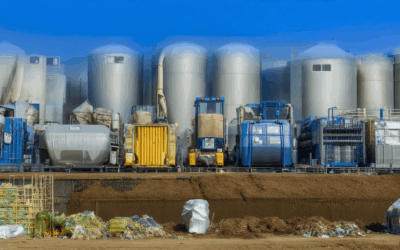Sustainable waste farming represents a transformative approach to agriculture, offering a pathway toward environmental stewardship while ensuring productivity and profitability. As global concerns about resource depletion and climate change intensify, adopting eco-friendly practices has become essential for both farmers and the planet. This article delves into the core principles and practices of sustainable waste farming, exploring how it minimizes environmental impact, maximizes resource efficiency, and fosters long-term agricultural sustainability. From innovative farming methods to effective waste management strategies, we will examine how sustainable waste farming addresses critical challenges and paves the way for a greener future. By understanding the key components of sustainable farming, including the 3 Ps—people, planet, and profit—we can unlock the potential of this approach to revolutionize modern agriculture. Whether you’re a seasoned farmer or new to the concept, this exploration will provide valuable insights into the benefits of sustainable waste farming and its role in shaping a more sustainable world.
Key Takeaways
– Sustainable Practices Reduce Waste Impact: Adopting eco-friendly waste management strategies minimizes environmental harm and promotes resource efficiency.
– Community Engagement Drives Fairness: Ensuring equitable access to sustainable practices fosters social justice and supports marginalized populations.
– Long-Term Financial Viability: Sustainable waste farming practices enhance profitability, making businesses more resilient to market changes and resource constraints.

What Farming Method is the Most Environmentally Friendly?
There isn’t a single farming method that is universally considered the most environmentally friendly, as different methods offer various benefits depending on the specific environmental goals. However, several farming practices stand out for their positive impact on the environment:
- Hydroponics : Known for its water-saving capabilities, hydroponics grows plants without soil, using nutrient-rich water solutions. It significantly reduces water usage compared to traditional farming and minimizes the need for synthetic chemicals, making it highly sustainable.
- Organic Farming : This method avoids synthetic pesticides, fertilizers, and genetically modified organisms (GMOs), promoting natural processes and biodiversity. While it may not always be as water-efficient as hydroponics, it contributes to healthier ecosystems and reduces pollution from chemical runoff.
- Agroforestry : Combining agriculture with forestry, this practice involves planting trees alongside crops. It enhances soil health, improves moisture retention, and provides shade for plants, reducing the need for additional irrigation. Additionally, it helps combat climate change by sequestering carbon dioxide.
- Crop Rotation : Rotating crops can improve soil fertility, reduce pest populations, and minimize the reliance on synthetic fertilizers. This method is eco-friendly as it maintains healthy soils and reduces agricultural runoff that can harm local waterways.
- Vertical Farming : Utilizing vertical spaces efficiently, vertical farming can reduce the environmental impact by minimizing land use and optimizing resource utilization. However, it requires careful energy management for lighting and temperature control.
Each of these methods offers unique advantages, and the most environmentally friendly approach often depends on the specific context and priorities of the farm. For instance, hydroponics might be ideal for water-scarce regions, while agroforestry could be prioritized in areas focused on carbon sequestration. Combining these practices can further enhance sustainability.
To learn more about these sustainable farming methods and how they can be implemented effectively, visit our resources on sustainable farming .
What is Zero Waste Farming?
Zero waste farming is an agricultural approach focused on minimizing waste generated during farming operations while maximizing resource efficiency. It integrates sustainable practices to reduce reliance on synthetic chemicals, conserve water, and protect soil health, ultimately promoting environmental sustainability and food security.
Key Principles of Zero Waste Farming
- Sustainable Resource Use: Minimizes the use of non-renewable resources and focuses on renewable alternatives like compost and organic fertilizers.
- Soil Health Preservation: Uses techniques like crop rotation, cover cropping, and reduced tillage to maintain fertile soil and prevent erosion.
- Water Conservation: Implements drip irrigation, rainwater harvesting, and mulching to minimize water usage and retain moisture in the soil.
- Organic Practices: Rejects synthetic pesticides and herbicides, relying instead on natural pest control methods and biological pest suppression.
- Waste Reduction: Converts farm waste into valuable resources through processes like composting and biogas production.
Benefits of Zero Waste Farming
- Improves soil fertility and long-term agricultural productivity.
- Reduces greenhouse gas emissions and contributes to climate change mitigation.
- Conserves water resources and reduces pollution in waterways.
- Enhances biodiversity by creating habitats for beneficial organisms.
- Minimizes costs associated with chemical inputs and waste management.
Examples of Zero Waste Farming in Action
Many farms worldwide are adopting zero-waste practices. For instance, certain organic farms compost nearly all their waste, turning it into nutrient-rich amendments for crops. Others utilize anaerobic digestion to convert livestock waste into biogas for energy production.
The Role of Technology in Zero Waste Farming
Modern innovations like precision agriculture tools and waste-to-resource systems are accelerating the adoption of zero-waste farming. These technologies enable farmers to monitor resource use and optimize waste management more effectively.
Conclusion
Zero-waste farming represents a holistic approach to agriculture that aligns with global sustainability goals. By embracing ecological practices, farmers can contribute to a healthier planet and more resilient food systems. The transition to zero-waste farming is not just about environmental protection—it’s about creating a future where food production and ecological health go hand in hand.

Is It Possible That Farming Can Be Sustainable?
Farming can indeed be sustainable through various practices and approaches that focus on environmental stewardship, economic viability, and social equity. Sustainable farming methods aim to enhance productivity while minimizing harm to the environment and promoting long-term agricultural resilience.
Key Aspects of Sustainable Farming
Sustainable farming integrates several core principles:
- Regenerative Agriculture: Practices like crop rotation, cover cropping, and reduced tillage help restore soil health and increase biodiversity.
- Resource Efficiency: Techniques such as drip irrigation, rainwater harvesting, and precision agriculture reduce water usage and improve resource utilization.
- Agroforestry: Integrating trees and other plants into farming systems enhances soil fertility, reduces erosion, and provides habitats for wildlife.
- Organic Farming: Avoiding synthetic pesticides and fertilizers promotes biological diversity and reduces contamination of air, water, and soil.
- Local and Regional Markets: Selling crops and products directly to nearby consumers or businesses reduces transportation emissions and supports community economies.
Benefits of Sustainable Farming
Adopting sustainable farming practices yields numerous benefits, including:
- Environmental Protection: Reduces greenhouse gas emissions, improves soil quality, and preserves biodiversity.
- Economic Stability: Enhances resilience against market fluctuations and input cost changes.
- Social Well-being: Supports rural development, job creation, and improved livelihoods for farmers and farmworkers.
Examples of Sustainable Farming in Action
Many farmers around the world are already embracing sustainable practices:
- Coffee farmers in Central America transitioning to shade-grown coffee to protect bird habitats and improve soil health.
- Cotton farmers adopting organic methods to reduce pesticide use and improve yields.
- Dairy farmers using manure as fertilizer and rotating grazing lands to maintain pasture health.
By implementing these practices, farming can not only sustain the land but also contribute positively to global environmental and economic health. Sustainable farming is not just possible—it’s essential for ensuring a healthy planet and a secure food future.

What are the 3 P’s of Sustainable Agriculture?
The three primary components of sustainable agriculture are often referred to by the acronym “3Ps”: People , Planet , and Profit . These pillars guide sustainable practices in agriculture, ensuring that farming methods benefit both the environment, society, and economic systems.
- People : This aspect focuses on social equity and well-being. Sustainable agriculture practices aim to create fair working conditions for farm workers, support local communities through job creation and food security, and promote human health by providing access to healthy foods.
- Planet : This refers to environmental stewardship. Sustainable practices minimize harm to ecosystems, conserve water and soil, reduce pollution, and adapt to climate change challenges. Techniques like crop rotation, cover cropping, and integrated pest management are examples that fall under this category.
- Profit : Financial sustainability ensures that farms are economically viable in the long term. This involves adopting cost-effective methods, market diversification, value-added production, and building resilience against external factors like market fluctuations or resource scarcity.
By balancing these three elements, sustainable agriculture promotes a holistic approach to food production that is environmentally responsible, socially just, and economically profitable.
What are the three pillars of ESG?
The three pillars of ESG are:
- Environmental: Focuses on the company’s impact on the environment, including reducing emissions, using sustainable resources, and complying with environmental regulations.
- Social: Relates to the company’s interactions with stakeholders, including employees, customers, and the community, often involving diversity, equity, and inclusion practices.
- Governance: Involves how the company is managed, including transparency, accountability, and adherence to legal and ethical standards.

What Are the Three Pillars of Sustainable Agriculture?
The three core principles of sustainable agriculture are:
- Environmental Health : Implementing practices that protect ecosystems, reduce pollution, and promote biodiversity. This includes techniques like crop rotation, cover cropping, and minimizing synthetic inputs.
- Economic Profitability : Developing farming systems that are financially viable in the long term. Strategies such as integrated pest management, renewable energy use, and value-added product creation help ensure sustained economic returns.
- Social and Economic Equity : Ensuring equitable access to sustainable practices and resources for all individuals, particularly those from marginalized backgrounds. This involves education, community empowerment, and cooperative initiatives to level the playing field.
By focusing on these three pillars, sustainable agriculture creates a balanced approach that benefits both the environment and society while maintaining economic viability.




0 Comments